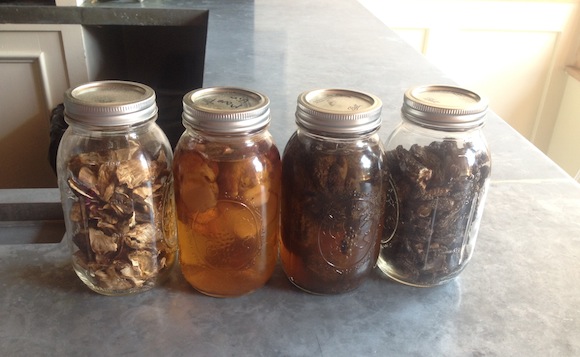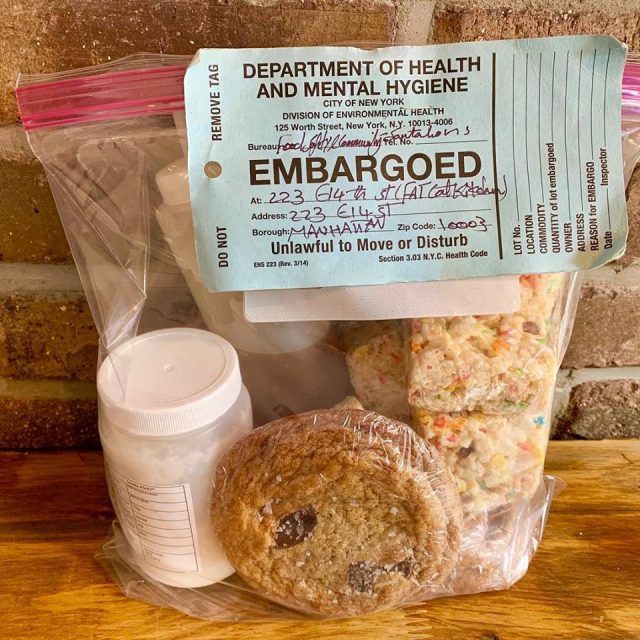
How much of your food skips the fork and goes straight from the fridge to the trash can? Probably too much. Even if you share a quarter of a mini-fridge, you’re probably not using everything you buy before it starts to stink up your and then your roommate’s partitioned fridge space. Americans are really good at buying more groceries than we can use, and it’s a huge waste of money, not to mention resources.
Chef Andrew Whitcomb, of Colonie (127 Atlantic Ave), teaches us some of the tricks he uses to keep margins down at his restaurant, so we can enjoy our perishables before they truly perish.
We came up with some foods that often turn in our refrigerators before we get a chance to use them and Chef Whitcomb shared his mastermind strategies for optimal deliciousness, with things like pickling, sauces and…carrot jerky?
Eggs: You can pickle those! Start by putting eggs in with cold water and bring it up to a boil for ten minutes. Peel them and put them in a mason jar with white vinegar. You can also do this with beets, vegetables and any herbs. Colonies uses one part vinegar, one part water, and one part sugar, as their pickling brine, except they don’t use sugar for eggs, because that would taste weird. Shelf life = forever.
Milk: You can’t pickle this (duh), but you can turn it into cheese! “Ricotta is really easy,” Whitcomb told us. Colonie uses whole milk and the juice of one lemon (one tablespoon/gallon is the ratio). Heat your not-quite-spoiled milk on the stove to to 190 degrees, let it cool and at 115-120 degrees (yes, you need a kitchen thermometer), stir in the lemon juice and a tablespoon of salt gently, as not to break the curds. Separate it out and you’ll have ricotta and whey!
Meat: If it’s kielbasa or chorizo, you can pickle it with the brine recipe above. Whitcomb explains that the first sign meat is going bad is it will start to turn grey and oxidize. Then it will get sticky or slimy. The best way to handle this is make a large batch of a recipe and freeze immediately before the meat turns. If it’s ground beef or chicken parts and you don’t have sausage stuffer in your home kitchen (we know you don’t), you’re going to have to cook it into a bolognese sauce (or chili or something along those lines) and freeze it. “Always freeze it pre-portioned,” suggests Whitcomb, “it’s refreezing meat the second time that will fuck it all up.”
Tomatoes: You can cook these down into preserves or jam. Depending on how many tomatoes you have, use 20% sugar, 5% water and 75% tomatoes, and cook them slowly on the stove until the mixture is nice and thick and ready for your blender. You can use it blended as preserves or continue to cook until it thickens into a jam.
You can also dehydrate tomatoes and use them like sun dried tomatoes! Use the lowest setting in your oven and let them cook overnight. If they’re really big, cut them in half or slices first. Cherry tomatoes also work well.
Mushrooms: Dry them or pickle them! (Dehydration instructions above). You can add dried mushrooms to soup or sauce for extra meaty, umami flavor. You can also grind them up and use them as seasoning or in savory doughs. Mushrooms can also be stored in vinegar– apple vinegar, champagne vinegar, any vinegar will do to preserve the mushrooms and infuse the vinegar with flavor! Chop them up and add them to burger meat, or use them like you would the dried mushrooms. “I’ve made so many jars of mushrooms [this summer] I’ve had to slow down!” Whitcomb told us. The uses are pretty much endless.
Baby Carrots: Make carrot jerky. Cook the carrots by boiling or roasting them, and then slowly dry them in the oven for the texture of beef jerky. Putting them in your fridge overnight will rehydrate carrots to “a cool taffy texture,” according to Whitcomb. Colonie uses carrot jerky in salads, and if it’s good enough for them, it’s good enough for us. If you have a juicer, you can also juice the carrots and add the juice to live vinegar to make a dressing as well. Bonus: You can dry out the pulp from your juiced carrots and make a carrot salt.
And with all these tasty, money saving techniques, you can maybe afford a meal at Colonie one of these days!
Follow Melissa as she tries not to waste food at @Melissabethk
One Response to
Leave a Reply




Great tips. Thank you! But when it comes to milk I often use this little trick to make it last longer and use as usual. There’s really no difference in taste :) http://www.listonic.com/protips/get/bsilikbbba